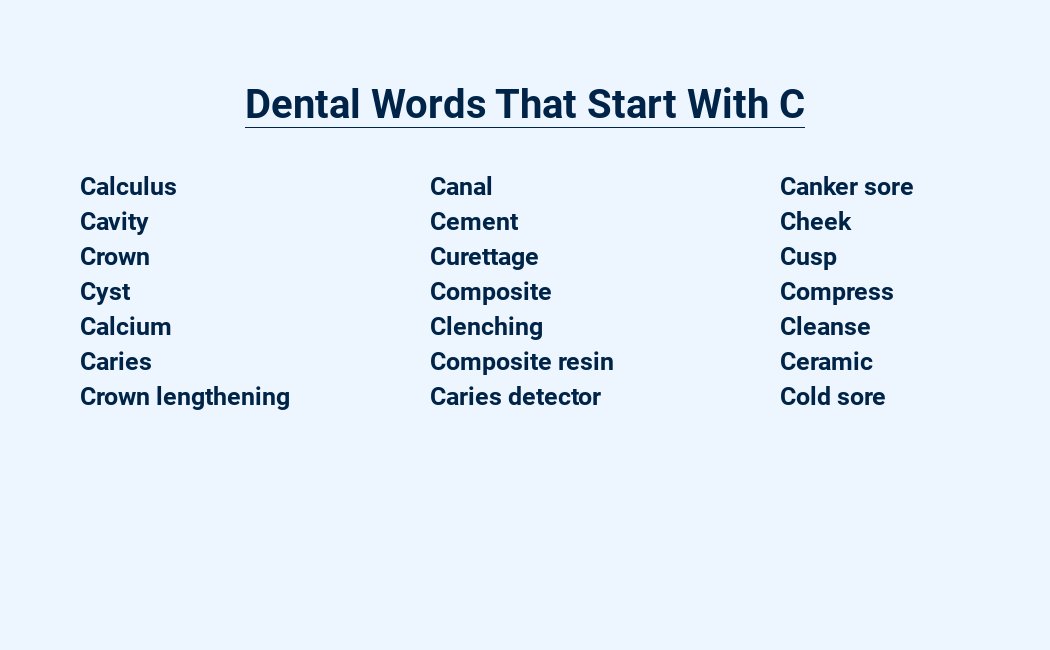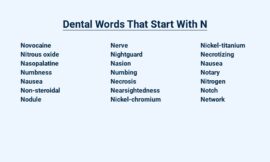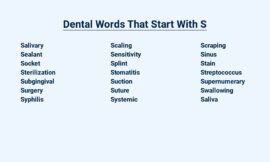Embark on a dental expedition, delving into the world of “C” terminologies. From the pesky calculus clinging to teeth to the discomfort of a canker sore, from cavities and cement fillings to the structure of cheeks and the importance of cleaning, we’ll uncover the intricacies of dental health, one term at a time.
| Term | Definition |
|---|---|
| Calculus | Mineralized plaque that forms on teeth and can contribute to cavities and gum disease. |
| Canine | A pointed tooth, located near the front of the mouth, used for tearing and gripping food. |
| Canker Sore | A small, painful ulcer that can develop on the inside of the mouth. |
| Cavity | A hole in a tooth caused by decay. |
| Cementum | A tissue that covers the root of a tooth and helps to hold it in place. |
| Composite Filling | A type of filling used to repair cavities, made from a mixture of resin and glass. |
| Crown | A cap that is placed over a tooth to protect it or improve its appearance. |
| Cuspid | Another name for a canine tooth. |
| Cyst | A sac filled with fluid or pus that can develop in the mouth. |
Calcium: A mineral that is essential for the development and maintenance of healthy teeth and bones.
Calculus: A hard, mineralized deposit that forms on the teeth as a result of plaque buildup.
Caries: A disease of the teeth that is caused by bacteria that feed on the sugars in food. This can lead to the formation of cavities.
Cavity: A hole in the tooth that is caused by caries.
Cementum: A hard, calcified tissue that covers the root of the tooth.
Centric occlusion: The position of the teeth when they are in maximum contact with each other.
Ceramic: A type of material that is used to make dental crowns and bridges.
Chairside: The area in a dental office where the patient sits during treatment.
Checkup: A regular dental examination to assess the health of the teeth, gums, and mouth.
Cheek: The soft tissue that forms the sides of the mouth.
Child Dentistry: A branch of dentistry that focuses on caring for the teeth of children.
Chlorhexidine: An antiseptic that is used to kill bacteria in the mouth.
Cleft lip: A birth defect in which the lip is not fully formed.
Cleft palate: A birth defect in which the roof of the mouth is not fully formed.
Clinician: A healthcare professional who provides dental care.
Composite Bonding: A procedure in which a tooth-colored resin material is used to repair or reshape a tooth.
Compression: The act of applying pressure to something.
Condyle: The rounded projection at the end of the mandible that fits into the temporal bone of the skull.
Cone Beam Computed Tomography (CBCT): A type of X-ray imaging that creates three-dimensional images of the teeth and jaws.
Consult: To seek the advice of a dental professional.
Contact point: The point at which two teeth touch each other.
Contra-angle: A type of dental handpiece that is used to access difficult-to-reach areas of the mouth.
Coping: A metal or ceramic structure that is used to support a dental crown.
Cosmetic Dentistry: A branch of dentistry that focuses on improving the appearance of the teeth and smile.
Cotton Roll: A small, absorbent cotton roll that is used to keep the mouth dry during dental procedures.
Crown: A cap that is placed over a tooth to restore its shape, strength, and appearance.
Crowding: A condition in which the teeth are too close together.
Curettage: A procedure in which a sharp instrument is used to remove plaque and calculus from the teeth.
Cure: To treat and eliminate a disease or condition.
Custody: The legal right to make decisions about a child’s upbringing.
Cyst: A sac filled with fluid or pus that can form in the mouth.
Cytology: The study of cells.
Dental Words Starting with the Letter “C”
Calculus
Calculus is a branch of mathematics that deals with change, rates of change, and limits.
It is used extensively in various fields, including physics, engineering, economics, and biology.
The fundamental concepts of calculus include derivatives and integrals.
Canker Sore
Canker sore, also known as aphthous ulcer, is a small, painful ulcer that develops on the inside of the mouth.
It is a common condition that can be caused by a variety of factors, including stress, hormonal changes, and certain foods.
Canker sores usually heal on their own within a few weeks.
Cavity
A cavity, also known as caries, is a hole in a tooth caused by the breakdown of tooth enamel. It is commonly caused by poor oral hygiene, allowing bacteria to form plaque and acids that erode the tooth’s surface.
Regular brushing, flossing, and dental checkups can help prevent cavities.
Cement
Cement, a ubiquitous material in dentistry, forms the foundation of many restorative procedures. It securely bonds dental restorations like crowns, bridges, and fillings to the tooth structure, ensuring their stability and longevity.
Cheek
The cheek is the fleshy part of the face that forms the side of the mouth.
In dentistry, it refers to the area between the upper and lower jaws, which is important for chewing and speaking.
Cheek biting and cheek swelling are common dental issues related to this area.
Cleaning
Cleaning, an essential part of oral hygiene, involves removing plaque, bacteria, and food particles from teeth and gums to prevent tooth decay and gum disease. Regular cleaning at the dentist’s office, coupled with daily brushing and flossing, helps maintain a healthy smile.
Clenching
Clenching is the act of tightly holding or gripping something, often with the teeth or jaws.
In dentistry, it can refer to the involuntary or subconscious clenching of the teeth, also known as bruxism.
This condition can lead to teeth damage and other problems if left untreated.
Composite Bonding
Composite bonding is a restorative dental procedure that involves using tooth-colored resin to repair or improve the appearance of teeth.
The composite material is applied to the tooth and sculpted into the desired shape, then hardened with a light.
It is a versatile treatment that can be used to fill cavities, repair chips or cracks, close gaps between teeth, and whiten teeth.
Crown
Crown: A dental restoration that covers the entire visible portion of a tooth, used to restore its strength, shape, size, appearance, or improve its overall function. Crowns are most commonly made of porcelain, metal, or a combination of both.
Crown lengthening
Crown lengthening is a dental procedure that exposes more of the tooth’s crown by removing gum tissue and bone. This can be done to improve the appearance of a gummy smile, to facilitate the placement of a dental crown or bridge, or to improve oral hygiene.
Crossbite
Crossbite is a dental condition where the upper teeth bite inside the lower teeth. This can cause problems with chewing, speaking, and jaw development.
Treatment options include braces, retainers, and surgery.
Final Verdict
The world of dentistry encompasses an array of terms beginning with the letter “C.” From the buildup of calculus to the discomfort of canker sores, from cavities requiring attention to the strength of dental crowns, each term plays a vital role in maintaining oral health. Understanding these terms empowers individuals to make informed decisions about their dental care, promoting a healthy and confident smile.
Regular checkups and consultations with dental professionals ensure optimal oral hygiene, preventing complications and preserving the beauty of your smile.




